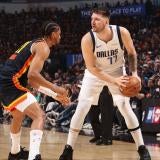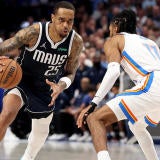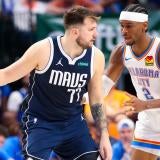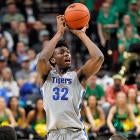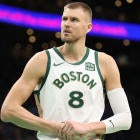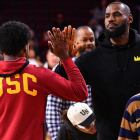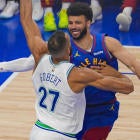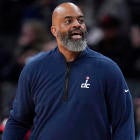In the NBA Draft, the value gap between a single pick can be sizable. The difference between picking No. 1 and No. 2 pick in a draft can be the separation between a future MVP-caliber player and a future All-Star. The difference between the fifth and sixth pick -- perhaps the difference between a role player and an end-of-bench contributor. And so on.
History tells us that picking higher doesn't guarantee you won't miss, to be certain, nor does it tell us that a future MVP can't be scooped up, say, 15th overall (See: Antetokounmpo, Giannis.). Because for every Zion Williamson or Anthony Davis, there's an Anthony Bennett or Hasheem Thabeet. No one has a 100 percent hit rate. The star power at the top of the draft is, in part, why moving up the board costs a pretty penny, and why it's rare you see teams inside the top five doing anything but staying put.
In this year's draft, the value at the top proves that especially true. There are role players you can find in the lottery this year and star power not in the consensus top five among all prospects, but the real boom potential -- the select few players who can be franchise building blocks -- lie at the top. The needle-movers.
To sort out the value, we conducted a thought exercise by separating this year's lottery candidates into tiers. The top-three prospects on the CBS Sports Big Board are in a tier of their own at the top.
Tier 1
LaMelo Ball | PG | Australia
The No. 1 overall prospect on my board, LaMelo Ball has the court vision, the passing and the playmaking of a future star. He's an offensive system unto himself. If he can tweak the shot and improve as a distance shooter -- he shot just 25% from the 3-point line playing in the NBL last season -- my bet is on him becoming the biggest hit in this class.
Anthony Edwards | SG | Georgia
Scouts ooh and ahh at Anthony Edwards' athleticism, but it's his shot-creation and offensive upside that has me sucked in. (OK, the athleticism has me sold, too.) He's a genetic marvel, and still just 18 years old -- one of the youngest players in this class.
Killian Hayes | PG | France
Long considered an elite point guard, French star Killian Hayes' prospects finally met production this past season when he shot 39% from 3-point range in EuroCup play and solidified his standing as a top-10 pick. He also improved as a shot-creator, adding to an already-diverse passing and playmaking arsenal, putting him ahead of our second tier and at the bottom of our first.
Tier 2
Onyeka Okongwu | C | USC
Not quite a modern big, and yet Onyeka Okongwu has the physical tools you can't look past. He's a 6-foot-9 shot-blocking savant who can dive to the rim, finish in the post and defend in space. Even without a developed offensive game from distance, he has all the ingredients of what I believe makes him the best big man in this draft class.
James Wiseman | C | Memphis
Playing just three college games before abruptly departing the Memphis program, questions still loom about James Wiseman's motor, his shot, his feel and competitive drive. But being 7-foot-1 with a 7-foot-6 wingspan and gifted with gobs of raw talent is enough for teams to bet on the upside early in the lottery, making him a second-tier talent.
Obi Toppin | PF | Dayton
Obi Toppin joined an exclusive list of efficient superstars this past season at Dayton, becoming the third player in college since 2000 to average at least 20 points per game while shooting 69% or better from 2-point range. Only Zion Williamson (Duke) and Michael Bradley (Villanova) have achieved such a feat. It helps underscore the type of prospect Toppin is: an effective scorer around the rim who should be a high-end rim-runner right away. Shooting 39% from 3-point range last season should portend well for his future, too.
Tier 3
Tyrese Haliburton | PG | Iowa State
Speaking of efficiency, Tyrese Haliburton's game screams it. Last season at Iowa State, he averaged 15.2 points and 6.5 assists per game while shooting 41.9% from 3-point range, 59.2% from 2-point range and 82.2% from the foul line. He's an analytics darling on both ends of the court. Some team may nitpick and use the skinny frame or odd mechanical look of his shot to bump him down the board, but that team is going to have some regrets when he turns out to be one of this draft's best steals in the mid-lottery. The smarts and feel he has I'm glad to bet on.
Deni Avdija | SF | Israel
The term "point-forward" gets overused in the draft community, but in this particular draft, it's apt phrasing to describe Deni Avdija's potential. He's a 6-foot-9 forward with guard skills who can run the break, make crisp passes and knock down perimeter shots. He's a jumbo guard who can play a number of different positions. The versatility as a scorer, passer and creator at his size is a rarity.
Tier 4
Isaac Okoro | SF | Auburn
The 6-foot-6, 225-pound frame -- for a freshman -- pops when evaluating Isaac Okoro. As does the way he uses it. He's a switchable defender who can guard every position, an absolute menace on the perimeter who loves taking on a challenge. Shooting just 29% from the 3-point line is the biggest concern, but perhaps the only red flag that separates him from being a lock inside the top three of this draft. As one scout told me, he's not top five this year on their board, but in five years, he could be a top-five player from this draft.
Cole Anthony | PG | UNC
Playing on a bad North Carolina team made Cole Anthony, with little space to create, look a bit like a high-volume, low-efficiency scorer. But when I paint the picture of his draft prospects I'm taking that into account. What I see is an electric shot-maker who can help run an offense and generate buckets from pretty much any situation.
Tyrese Maxey | SG | Kentucky
The enigma that is Tyrese Maxey centers around one number: 29.2%. That's the rate at which he made 3-pointers at Kentucky last season. It's not good, but other markers, like his 83.3% free-throw shooting, suggest that number could (and should) improve in time. The eye test bores that out; he's got a smooth, fluid release that looks sound mechanically. Whether it comes around or not, Maxey's a dynamic driver and initiator on offense with a lockdown defensive style on the perimeter to boot. The tools of a top-five pick are there.
Devin Vassell | SF | Florida State
Teams may find that the archetypal 3-and-D wing in this draft is worth waiting for in Devin Vassell, Florida State's secret two-way weapon from last year. He averaged 12.7 points, 5.1 rebounds, 1.5 steals, 1.0 blocks and shot 41.5% from the 3-point line last season as a playmaker on both ends. He also has some untapped potential as a shot-creator on offense that went underutilized at FSU. In terms of high-upside wings, Vassell is on the short list in this draft class.
Aaron Nesmith | SF | Vanderbilt
Before Aaron Nesmith's season was cut short due to injury, he led the SEC in scoring (23.0 PPG) and was averaging 52.2% as a 3-point shooter. That's his game: a preternatural scorer who can provide an offensive punch from deep. His ranking in the 95th percentile as a spot-up shooter bodes well for his projection to become an elite-level role player in the NBA.








